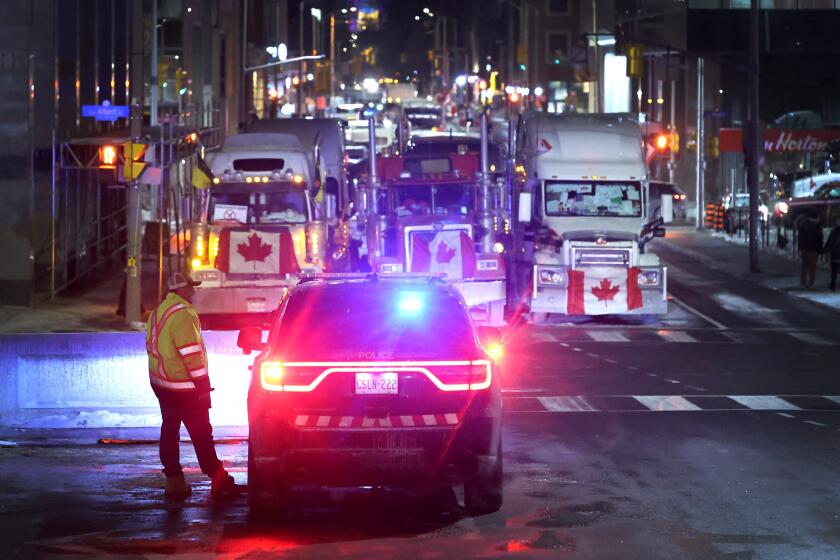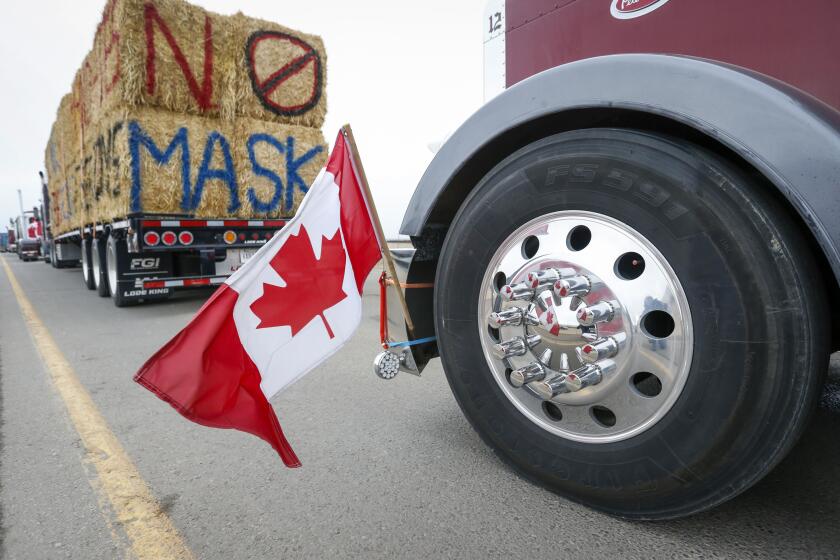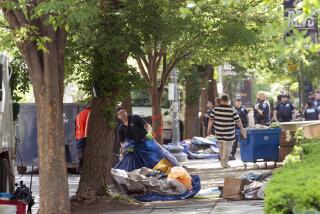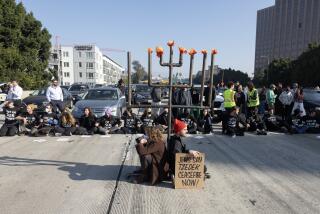Truckers in Ottawa remain defiant despite arrests of 2 protest leaders
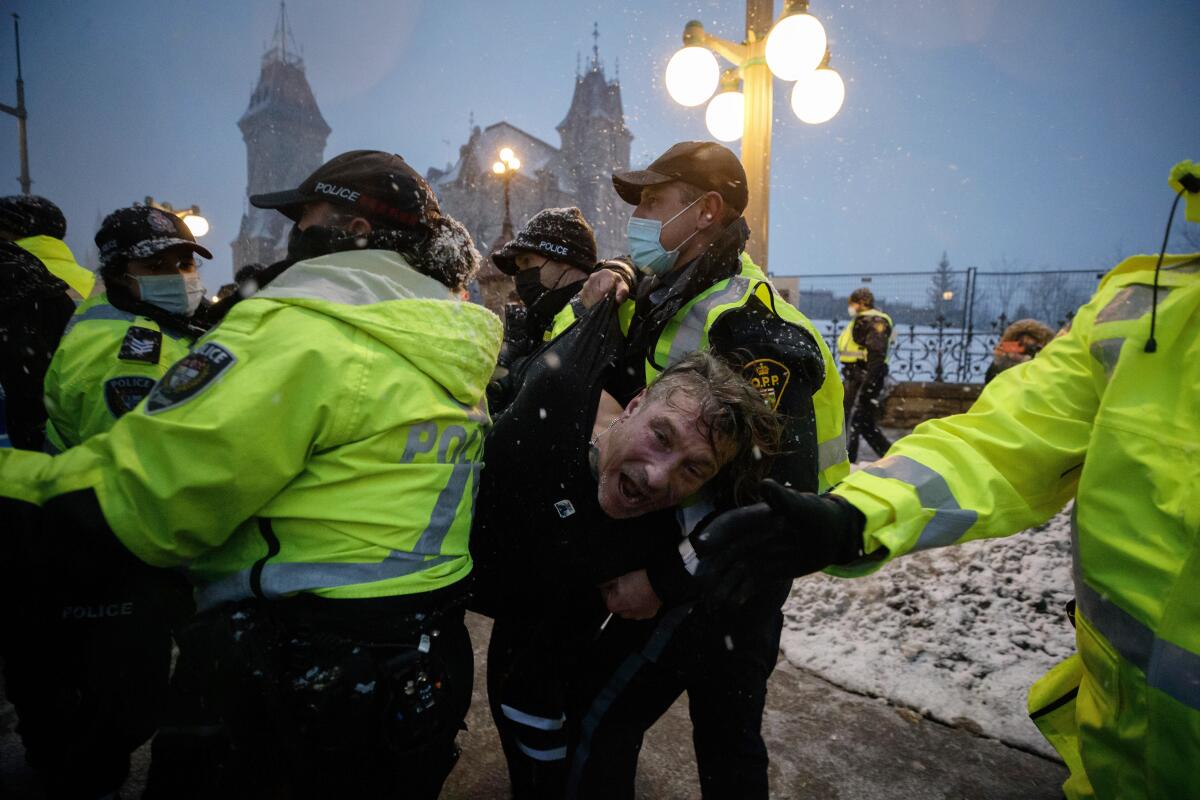
- Share via
OTTAWA — Hundreds of truckers clogging Canada’s capital stood their ground and defiantly blasted their horns Thursday, even as police arrested two protest leaders and threatened to break up the nearly three-week protest against the country’s COVID-19 restrictions.
Busloads of police arrived near Ottawa’s Parliament Hill, and workers put up extra fences around government buildings. Police also essentially began sealing off much of the downtown area to outsiders to prevent them from coming to the aid of the protesters.
“The action is imminent,” said interim Ottawa Police Chief Steve Bell. “We absolutely are committed to end this unlawful demonstration.”
Police arrested organizers Tamara Lich and Chris Barber around Parliament Hill, but officers were not moving in force on the demonstrators. Police took Lich into custody late Thursday.
Police continued negotiating with the protesters and trying to persuade them to go home, Bell said. “We want this demonstration to end peacefully,” he said, but added: “If they do not peacefully leave, we have plans.”
Canada deals with images of truckers and others protesting against COVID-19 mandates and leveling other grievances, sometimes with vulgarity and incivility.
Many of the truckers in the self-styled Freedom Convoy appeared unmoved by days of warnings from police and the government that they were risking arrest and could see their rigs seized and bank accounts frozen.
“I’m prepared to sit on my ass and watch them hit me with pepper spray,” said one of their leaders, Pat King. As for the trucks parked bumper-to-bumper, he said: “There’s no tow trucks in Canada that will touch them.”
King later told truckers to lock their doors.
Amid the rising tensions, truckers outside Parliament blared their horns in defiance of a court injunction against honking, issued for the benefit of neighborhood residents.
Ottawa represented the movement’s last stronghold after weeks of demonstrations and blockades that shut down border crossings into the U.S., inflicted economic damage on both countries and created a political crisis for Prime Minister Justin Trudeau.
The protests have shaken Canada’s reputation for civility and rule-following and inspired similar convoys in France, New Zealand and the Netherlands.
“It’s high time that these illegal and dangerous activities stop,” Trudeau declared in Parliament, not far from where the more than 300 trucks were parked.
One explanation for the reaction: The pandemic has been subsumed into the pre-existing culture war fight.
“They are a threat to our economy and our relationship with trading partners,” he said. “They are a threat to public safety.”
Ottawa police began locking down a wide swath of the downtown area, allowing in only those who live or work there after they pass through one of more than 100 checkpoints, the interim chief said.
Police were especially worried about the children among the protesters. Bell said police were working with child-welfare agencies to determine how to safely remove the youngsters before authorities move in.
This week, the prime minister invoked Canada’s Emergencies Act, empowering law enforcement authorities to declare the blockades illegal, tow away trucks, arrest the drivers, suspend their licenses and take other measures.
On Thursday, Trudeau and some of his top ministers took turns warning the protesters to leave, in an apparent move by the government to avert a clash, or at least show it had gone the extra mile to avoid one.
Deputy Prime Minister Chrystia Freeland said the government began freezing truckers’ accounts as threatened. “It is happening. I do have the numbers in front of me,” she said.
Ottawa police, likewise, handed out leaflets for the second straight day demanding the truckers end the siege and also placed notices on vehicles informing owners how and where to pick up their trucks if they are towed.
Economies on both sides of the U.S.-Canada border are threatened by the blockade, with Detroit automakers starting to shut down plants.
The occupation has infuriated many Ottawa residents.
“We’ve seen people intimidated, harassed and threatened. We’ve seen apartment buildings that have been chained up. We have seen fires set in the corridors. Residents are terrorized,” said Canadian Public Safety Minister Marco Mendicino.
The protests by demonstrators in trucks, tractors and motor homes initially focused on Canada’s vaccination requirement for truckers entering the country but soon morphed into a broader attack on COVID-19 precautions and Trudeau’s government.
The biggest, most damaging of the blockades at the border took place at the Ambassador Bridge between Windsor, Ontario and Detroit. Before authorities arrested dozens of protesters last weekend and lifted the siege, it disrupted the flow of auto parts between the two countries and forced the industry to curtail production.
The final blockade, in Manitoba, ended peacefully on Wednesday.
The movement has drawn support from right-wing extremists and veterans, some of them armed — one reason authorities have hesitated to move against them.
Fox News personalities and U.S. conservatives such as former President Trump have egged on the protests. Trudeau complained on Thursday that “roughly half of the funding to the barricaders here is coming from the United States.”
Some security experts said that dispersing the protest in Ottawa could be tricky and dangerous, with the potential for violence, and that a heavy-handed law enforcement response could be used as propaganda by antigovernment extremists.
Trucks were parked shoulder to shoulder downtown, some with tires removed to hamper towing.
“There is not really a playbook,” said David Carter, a professor at Michigan State University’s School of Criminal Justice and a former police officer. “I know there are police chiefs in the U.S. looking at this and developing strategic plans and partnerships to manage a protest like this if it should occur in their cities.”
The presence of children also complicated the planning. As a showdown seemed to draw near, Canadian Emergency Preparedness Minister Bill Blair said: “To those who have children with them, this is no place for children. Take them home immediately.”
More to Read
Sign up for Essential California
The most important California stories and recommendations in your inbox every morning.
You may occasionally receive promotional content from the Los Angeles Times.
